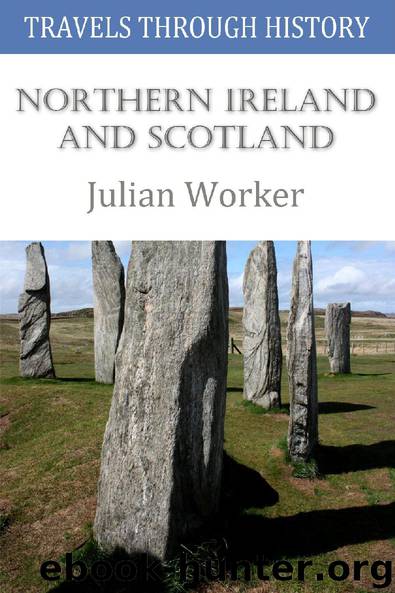Travels through History - Northern Ireland and Scotland by Julian Worker

Author:Julian Worker
Language: eng
Format: epub
Tags: callanish, callanais, lewis, harris, lewis and harris, outer Hebrides, Hebrides, dun, carloway, broch, dun carloway, arnol, blackhouse, house, black, northern Ireland, Edinburgh, Scotland, botanical gardens, rosslyn, chapel, history, travel, stone circle, dryburgh, abbey, borders, Midlothian, royal mile, greyfriars
ISBN: 9781785388064
Publisher: Andrews UK Limited 2017
Published: 2017-11-27T00:00:00+00:00
Dun Carloway Broch, Isle of Lewis
Dun Carloway, or Dun Charlabhaigh in Gaelic, is a well-preserved broch in a stunning location overlooking Loch Roag on the west coast of Lewis. Dun Carloway was probably built sometime in the last century BC. As with all brochs, it would have served as a defensible residence for an extended family complete with accommodation for animals at ground floor level. It was a visible statement of power and status in the local area.
The broch at Dun Carloway is extremely well preserved. It was built at a time when brochs were already starting to be replaced by other forms of housing less demanding on scarce resources (and wood in particular), and it is not known how long it remained in use. It seems to have been still largely complete in the 1500s when some of the Morrison clan sought refuge inside the broch after being discovered stealing the local MacAulays’ cattle. Donald Cam MacAulay climbed the outside of the wall and threw in burning heather, smoking the Morrisons out.
The broch is next mentioned in 1797, in a report by the local minister. By this time, there was a theory that brochs were watchtowers used as defence against, or by, Vikings. Dun Carloway featured prominently in reports on Western Isles brochs in the latter part of the 1800s, and as a result it was one of the very first ancient monuments in Scotland to be taken into state care. By this time a large part of the wall had been removed, probably for recycling into the blackhouses built nearby.
I took a path leading up the hillside, giving views of the broch and the surrounding countryside. The side of the broch facing me was built on steep rock, and most of it remains as originally designed. As I rounded the broch to the entrance, on the north side, I was presented with a different picture. From here, I saw that the most easily accessible parts of the wall have been removed. What remains is a life-size cutaway model, exposing sections through the walls and showing much of their structure. Inside the broch several chambers are accessible at ground floor level, an area used to house farm animals.
The human residents would have lived 2m higher, above wooden flooring supported on a ridge that can still be seen running around the inside walls. The heat from the animals would have provided the family with extra warmth. As in other brochs, stairs are fitted between the inner and outer walls. There would probably have been several floors of accommodation beneath a conical roof. It says a lot about the construction techniques of the builders that the broch is still in existence to this day.
Download
This site does not store any files on its server. We only index and link to content provided by other sites. Please contact the content providers to delete copyright contents if any and email us, we'll remove relevant links or contents immediately.
How to Read Water: Clues and Patterns from Puddles to the Sea (Natural Navigation) by Tristan Gooley(3410)
Full Circle by Michael Palin(3391)
Into Thin Air by Jon Krakauer(3314)
How to Read Nature by Tristan Gooley(3251)
In Patagonia by Bruce Chatwin(2876)
The Lost Art of Reading Nature's Signs by Tristan Gooley(2625)
A Thousand Splendid Suns by Khaled Hosseini(2620)
Don't Sleep, There Are Snakes by Daniel L. Everett(2578)
Venice by Jan Morris(2527)
City of Djinns: a year in Delhi by William Dalrymple(2516)
The Queen of Nothing by Holly Black(2499)
The Songlines by Bruce Chatwin(2498)
L'Appart by David Lebovitz(2488)
The Big Twitch by Sean Dooley(2392)
Tokyo Geek's Guide: Manga, Anime, Gaming, Cosplay, Toys, Idols & More - The Ultimate Guide to Japan's Otaku Culture by Simone Gianni(2316)
Come, Tell Me How You Live by Mallowan Agatha Christie(2212)
Iranian Rappers And Persian Porn by Maslin Jamie(2159)
INTO THE WILD by Jon Krakauer(2157)
A TIME OF GIFTS by Patrick Leigh Fermor(2156)
